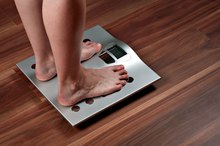What does fact checked mean?
At Healthfully, we strive to deliver objective content that is accurate and up-to-date. Our team periodically reviews articles in order to ensure content quality. The sources cited below consist of evidence from peer-reviewed journals, prominent medical organizations, academic associations, and government data.
The information contained on this site is for informational purposes only, and should not be used as a substitute for the advice of a professional health care provider. Please check with the appropriate physician regarding health questions and concerns. Although we strive to deliver accurate and up-to-date information, no guarantee to that effect is made.
How Many Calories Are Necessary Per Day to Lose 60 Pounds?
Losing 60 lbs requires monitoring your calorie intake so that you consume an appropriate number of calories per day to allow yourself to lose weight. Losing a significant amount of weight takes time, but with carefully-monitored calorie goals, you can lose 60 lbs at a healthy rate.
Weight Loss
Losing weight requires that you burn more calories than you consume over a period of time. You can increase the number of calories you burn through exercise, and you can limit your calorie intake by eating fewer calories every day. Every pound of fat loss requires that you burn 3,500 more calories than you consume 2. Losing 60 lbs, therefore, would require a total caloric deficit of 210,000.
- Losing weight requires that you burn more calories than you consume over a period of time.
- Every pound of fat loss requires that you burn 3,500 more calories than you consume 2.
Metabolism
How Many Calories to Eat When Running 7 Miles?
Learn More
Burning 210,000 more calories than you consume may seem daunting, but if you break the effort down to daily goals, it’s not nearly as difficult. First calculate how many calories you burn naturally via your metabolic rate. A woman calculates her rate with 655 + (4.35 X weight in lbs) + (4.7 X height in inches) – (4.7 X age in years). A man finds his basal metabolic rate with 66 + (6.23 X weight in lbs) + (12.7 X height in inches) – (6.8 X age in years).). Once you have this value, subtract 500 from the total to determine how many total calories to consume every day.
- Burning 210,000 more calories than you consume may seem daunting, but if you break the effort down to daily goals, it’s not nearly as difficult.
- A woman calculates her rate with 655 + (4.35 X weight in lbs) + (4.7 X height in inches) – (4.7 X age in years).
Considerations
Consuming 500 fewer calories than you burn everyday will equate to 3,500 calories and thus one pound of fat loss per week. This means it will take you about 60 weeks to lose 60 lbs. It’s typical, however, to burn more calories earlier on in the weight loss effort 2. Losing weight gradually allows your body systems to adapt to changes and typically leads to more permanent healthy lifestyle changes.
- Consuming 500 fewer calories than you burn everyday will equate to 3,500 calories and thus one pound of fat loss per week.
- This means it will take you about 60 weeks to lose 60 lbs.
Related Articles
References
- BMI Calculator: BMR Formula
- American Council on Exercise: Trimming Off the Fat
- Hall KD, Sacks G, Chandramohan D, et al. Quantification of the effect of energy imbalance on bodyweight. Lancet. 2011;378(9793):826-37. doi:10.1016/S0140-6736(11)60812-X
- Centers for Disease Control and Prevention. Physical activity for a healthy weight. Updated May 15, 2015.
- Viana RB, Naves JPA, Coswig VS, et al. Is interval training the magic bullet for fat loss? A systematic review and meta-analysis comparing moderate-intensity continuous training with high-intensity interval training (HIIT). Br J Sports Med. 2019;53(10):655-664. doi:10.1136/bjsports-2018-099928
- Ainsworth BE, Haskell WL, Herrmann SD, et al. 2011 Compendium of Physical Activities: A second update of codes and MET values. Med Science Sports Exerc. 2011;43(8):1575-1581. doi:10.1249/mss.0b013e31821ece12
- Donnelly JE, Blair SN, Jakicic JM, Manore MM, Rankin JW, Smith BK. Appropriate physical activity intervention strategies for weight loss and prevention of weight regain for adults. Med Science Sports Exerc. 2009;41(2):459-471. doi:10.1249/mss.0b013e3181949333
- Sanghvi A, Redman LM, Martin CK, Ravussin E, Hall KD. Validation of an inexpensive and accurate mathematical method to measure long-term changes in free-living energy intake. Am J Clin Nutr. 2015;102(2):353-358. doi:10.3945/ajcn.115.111070
Writer Bio
Kim Nunley has been screenwriting and working as an online health and fitness writer since 2005. She’s had multiple short screenplays produced and her feature scripts have placed at the Austin Film Festival. Prior to writing full-time, she worked as a strength coach, athletic coach and college instructor. She holds a master's degree in kinesiology from California State University, Fullerton.









